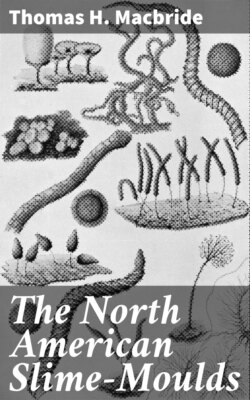Читать книгу The North American Slime-Moulds - Thomas H. Macbride - Страница 9
FOOTNOTES:
Оглавление[4] DeBary, Morphology and Biology of the Fungi, p. 428.
[5] See, however, Ceratiomyxa, p. 18, following.
[6] Harper in Botanical Gazette, Vol. XXX., p. 219.
[7] The following germination periods are furnished by Dr. Constantineanu (Inaugural Dissertation ueber die Entwickelungsbedingungen der Myxomyceten; Halle, 1907).
| Reticularia lycoperdon | 30 to 60 min. |
| Fuligo ovata | 30 to 90 min. |
| Stemonitis splendens | 5 to 6 hrs. |
| Perichaena depressa | 5 to 8 hrs. |
| Amaurochaete atra | 6 to 10 hrs. |
| Arcyria incarnata | 8 to 10 hrs. |
| Lycogala epidendrum | to 60 hrs. |
| Physarum didermoides | 1 to 10 da. |
| Dictydium cancellatum | 1 to 20 da. |
These records are for sowings in drop cultures, in distilled water, kept at temperature of 65°–70° F. (18°–20° C.).
Our own experiments have been made both with distilled water and tap-water with the advantage in favor of the latter. Dictydium cancellatum germinates in tap-water at temperature 70°–80° F. in 12–15 hours fresh from the field. Fuligo ovata spores were all swarming in about one hour at the same temperature. Jahn (Myxomycetenstudien; Ber. der Deutschen Bot. Ges. Bd. XXIII., p. 495) finds that the germination in some cases as Stemonitis species, is hastened by wetting, then drying, then wetting again.
Pinoy thinks microbes aid in germination (Bull. Soc. Myc. de France T. XVIII.).
[8] The plasmodium in this case chances to be red, scarlet, etc.
[9] "Die Myxomyceten sind ebenso den Pilzen wie den echten Thieren verwandt."—Rostafinski; closing sentence of the Versuch, thesis for his doctorate at the University of Strasburg, 1873.
[10] Botanical Gazette, XVII., pp. 389, etc.; 1892.
[11] Researches of Olive, Trans. Wis. Acad. Sci., Arts and Let., XV., Pt. 2, p. 771, and of Jahn, Ber. d. Deutsch Bot. Ges. XXVI., p. 342, and XXIX., p. 231, demonstrate synapsis, and accordingly some form of alternation among the slime-moulds. From the protracted and painstaking investigation of the German author it appears that in Didymium at least, and probably Badhamia synapsis immediately precedes spore-formation as in Ceratiomyxa; that the amœboid issue of the spores are haploid; the nuclei of the plasmodium, diploid; that the ordinary vegetative plasmodium is accordingly sporophytic. That is, the sporophytic phase is dominant, as in higher plants.
[12] Cf., 1884, Ver. Morph. u. Biol. der Pilz. Mycet. u. Bact., p. 478. Italics, in quotations, ours.
[13] See Journal of Mycology, Washington, D. C., Vol. VII., No. 2; also Bulletin No. 66, Agric. Station of Vermont. See also Bull. 33 Arizona Agric. Ex. Station: An Inquiry into the Cause and Nature of Crown-Gall. J. W. Tuomey. Also Bull. Torrey Bot. Club, Vol. 21, p. 26, where it appears that club-root may attack crucifers generally.
Professor B. M. Duggar in Fungous Diseases of Plants, pp. 97–102, gives to club-root an illustrated chapter.
Häntsch's Fluid:—
| Alcohol 90% | three parts |
| Water | two parts |
| Glycerine | one part |
